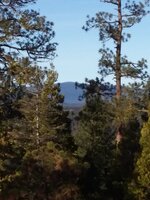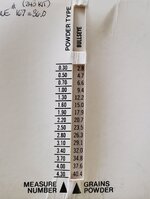Gold Supporter
- Messages
- 24,514
- Reactions
- 37,136
- Thread Starter
- #41
She is a widow, my wife is not worried.What we're all dying to know -- is she HOT ?
Follow along with the video below to see how to install our site as a web app on your home screen.
Note: This feature may not be available in some browsers.
She is a widow, my wife is not worried.What we're all dying to know -- is she HOT ?
My cell signal is 4 out of 5 bars up here. The tower is on the mountain in between the trees.I loaded up an CCI SRM primer #450 in a 9mm empty case no bullet and fired it off in my PT92. It went off easily and created a pretty good fireball. There was no muzzle flip at all.
As for the 9mm Lee Loader kit it needs a flaring tool or beveled bullets in my opinion. I am going to use a plated bullet installed in the case upside down to bell the case mouth a tad. Then hammer that bullet out with primer removal rod. I did one sample like that last night and it helped a lot but it will make for slowwwww loading. I have a few hours of hiking and brush whacking ahead of me this morning. Neighbor lady is coming over this afternoon for gorilla reloading lesson and pizza.

How long you down there for? I have a 357 loader and it probably has the flare. I could mail it down to you today, it'd likely be there Monday.She is a widow, my wife is not worried.
Thanks I appreciate that but we will get by. I have everything that I need for the lesson.How long you down there for? I have a 357 loader and it probably has the flare. I could mail it down to you today, it'd likely be there Monday.
Didn't even know I had a "Lee Dipper Slide Rule".Thanks for the tips. I am planning on having to load one at a time. I forgot my scale so unless the neighbor has one that measures grains I will be stuck with Lee .5cc dipper for loads.

I'll post this again for folks that may have not seen it. I shoot Blue Dot in my .223 Ruger American now that 17hmr is so expensive. I use a Nosler .35gr FBHP and 5 to 10 grains of the blue dot. I see that I already posted this some time ago.I am starting this thread in hopes of learning more about loading reduced loads from other reloaders.
With the economy of reloading costing more and the scarcity of components continuing to be a problem, more reloaders may benefit from playing around with reduced loads.
If you have favorite reduced load, technique, reduced load information source, advice, etc, please post it here.
As I experiment with reduced loads from titegroup in rifle cartridges to pistol cartridges with primer only, I will be posting here often with results and ideas.
Less pressure when sealing the bore completely? This seems counterintuitive.I read this statement on another forum. Does anybody here disagree with it?
"Also, cast bullet manuals like Lyman's provide plenty of reduced load data that can often be used with jacketed bullets because, contrary to what most handloaders would guess, jacketed bullets normally produce less pressure with the same powder charge, because they seal the bore more completely. (The exception is very hard cast bullets, but even then jacketed bullets don't result in more pressure.)"
Source: https://www.24hourcampfire.com/reduced-rifle-loads/
It was confusing to read but I got the impression that he feels gas is escaping past a jacketed bullet because it doesn't seal as tight as a soft cast bullet. Not sure if that is what he was getting at or if it is true. A jacketed bullet may have more friction than a cast bullet? If it does would that change pressure?Less pressure when sealing the bore completely? This seems counterintuitive.
My lead and plated Bullets feel like they have a softer recoil than my jacketed ones.
Not sure how pushing a jacketed bullet down the bore would create less pressure than a lead bullet? And yes I read his explanation.
I plan on trying some Blue Dot loads one day but I don't have much Blue Dot or Red Dot on hand and neither of those have been easily available lately. I have a bunch of Ramshot Competition, Alliant E3, Titegroup and IMR4227 so I am going to see if I can get some of those to work with reduced cast and jacketed loads in the rifle cartridges.I'll post this again for folks that may have not seen it. I shoot Blue Dot in my .223 Ruger American now that 17hmr is so expensive. I use a Nosler .35gr FBHP and 5 to 10 grains of the blue dot. I see that I already posted this some time ago.
223 & Blue Dot - 24hourcampfire
www.24hourcampfire.com
Resistance to movement increases pressure. This is why jamming a bullet into the lands creates higher pressure than allowing the bullet to get a running start.It was confusing to read but I got the impression that he feels gas is escaping past a jacketed bullet because it doesn't seal as tight as a soft cast bullet. Not sure if that is what he was getting at or if it is true. A jacketed bullet may have more friction than a cast bullet? If it does would that change pressure?
I wish we had more information as to why he would write this. From my experience, with matching bullet diameters and bearing surface, cast bullets have less pressure than jacketed bullets.I read this statement on another forum. Does anybody here disagree with it?
"Also, cast bullet manuals like Lyman's provide plenty of reduced load data that can often be used with jacketed bullets because, contrary to what most handloaders would guess, jacketed bullets normally produce less pressure with the same powder charge, because they seal the bore more completely. (The exception is very hard cast bullets, but even then jacketed bullets don't result in more pressure.)"
Source: https://www.24hourcampfire.com/reduced-rifle-loads/
Have you ever looked into picking up a rifle chambered in 17 Hornet. Lots of loads available using 10 to 12 grains of powder, very accurate round, much milder report than a 223, same flight trajectory as a 223 loaded at 3250 FPS with a 55 grain pill and very explosive on small game.I'll post this again for folks that may have not seen it. I shoot Blue Dot in my .223 Ruger American now that 17hmr is so expensive. I use a Nosler .35gr FBHP and 5 to 10 grains of the blue dot. I see that I already posted this some time ago.
223 & Blue Dot - 24hourcampfire
www.24hourcampfire.com
The opposite is true. No idea where that person got that notion.I read this statement on another forum. Does anybody here disagree with it?
"Also, cast bullet manuals like Lyman's provide plenty of reduced load data that can often be used with jacketed bullets because, contrary to what most handloaders would guess, jacketed bullets normally produce less pressure with the same powder charge, because they seal the bore more completely. (The exception is very hard cast bullets, but even then jacketed bullets don't result in more pressure.)"
Source: https://www.24hourcampfire.com/reduced-rifle-loads/
All good questions. My main question is, can I generally run jacketed bullets with starting cast load data for the same weight bullets?I wish we had more information as to why he would write this. From my experience, with matching bullet diameters and bearing surface, cast bullets have less pressure than jacketed bullets.
Both cast and jacketed bullets will seal the bore if the bullet diameter is correct.
There are way to many variables to make this blanket statement. Some of the variables, cast bullet bearing surface vs bearing surface of the jacketed bullet-most cast bullets have more bearing surface, are the cast bullets slightly larger in diameter, are bullets seated the same distance from the lands, style of cast bullet, lube or coating used on the cast bullet, crimping and I suspect there are additional variables.
I haven't.Have you ever looked into picking up a rifle chambered in 17 Hornet. Lots of loads available using 10 to 12 grains of powder, very accurate round, much milder report than a 223, same flight trajectory as a 223 loaded at 3250 FPS with a 55 grain pill and very explosive on small game.
I have a Ruger 77 in K-Hornet and have a pile of hand loads for it too but we burn a lot of ammo shooting rats.Have you ever looked into picking up a rifle chambered in 17 Hornet. Lots of loads available using 10 to 12 grains of powder, very accurate round, much milder report than a 223, same flight trajectory as a 223 loaded at 3250 FPS with a 55 grain pill and very explosive on small game.